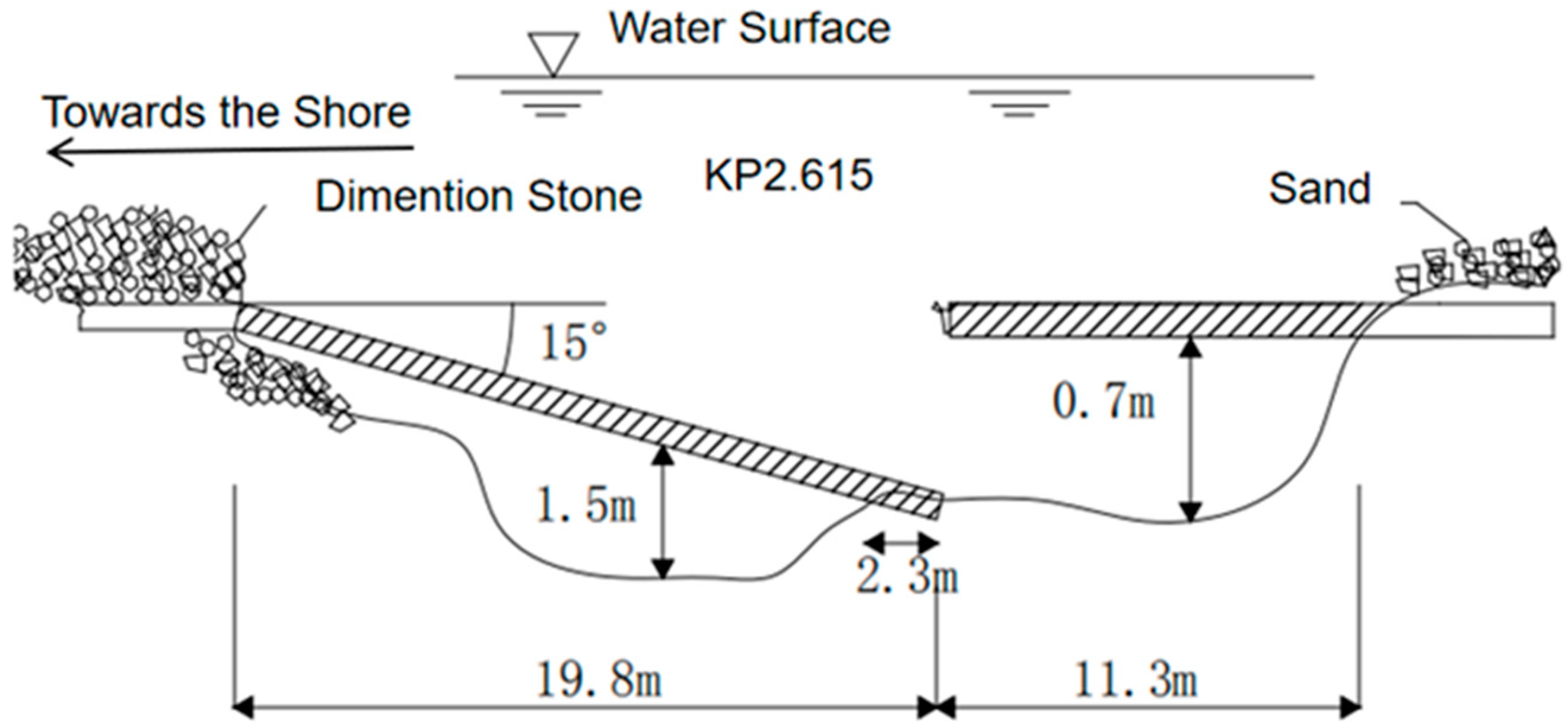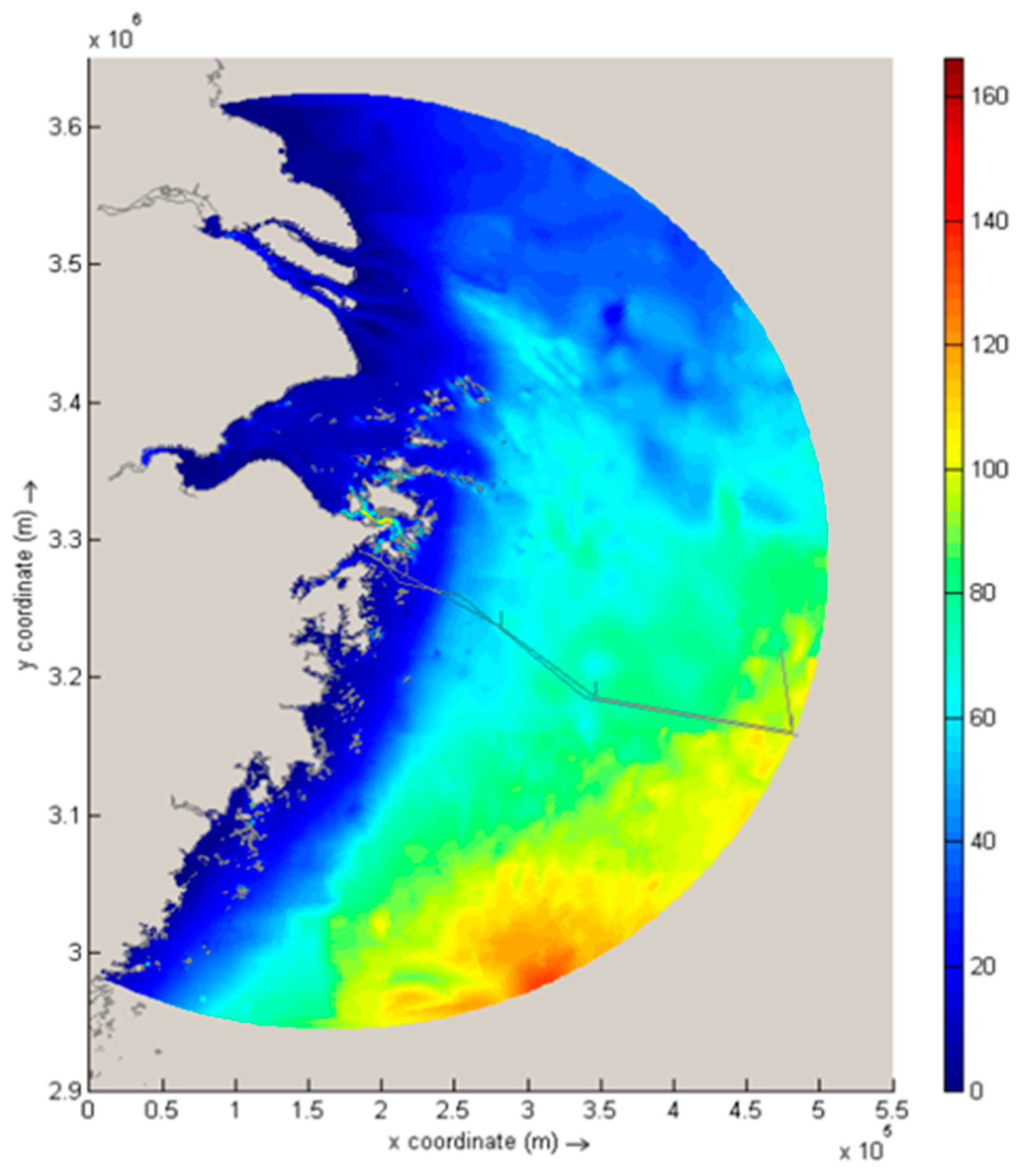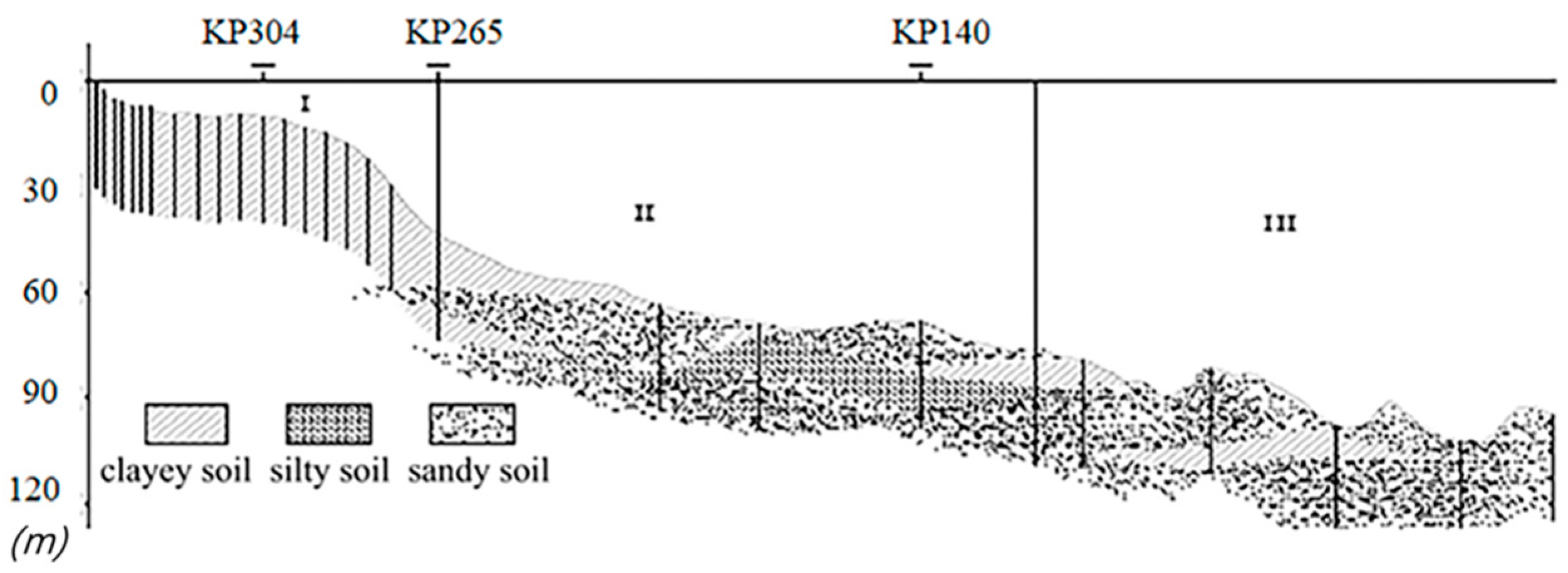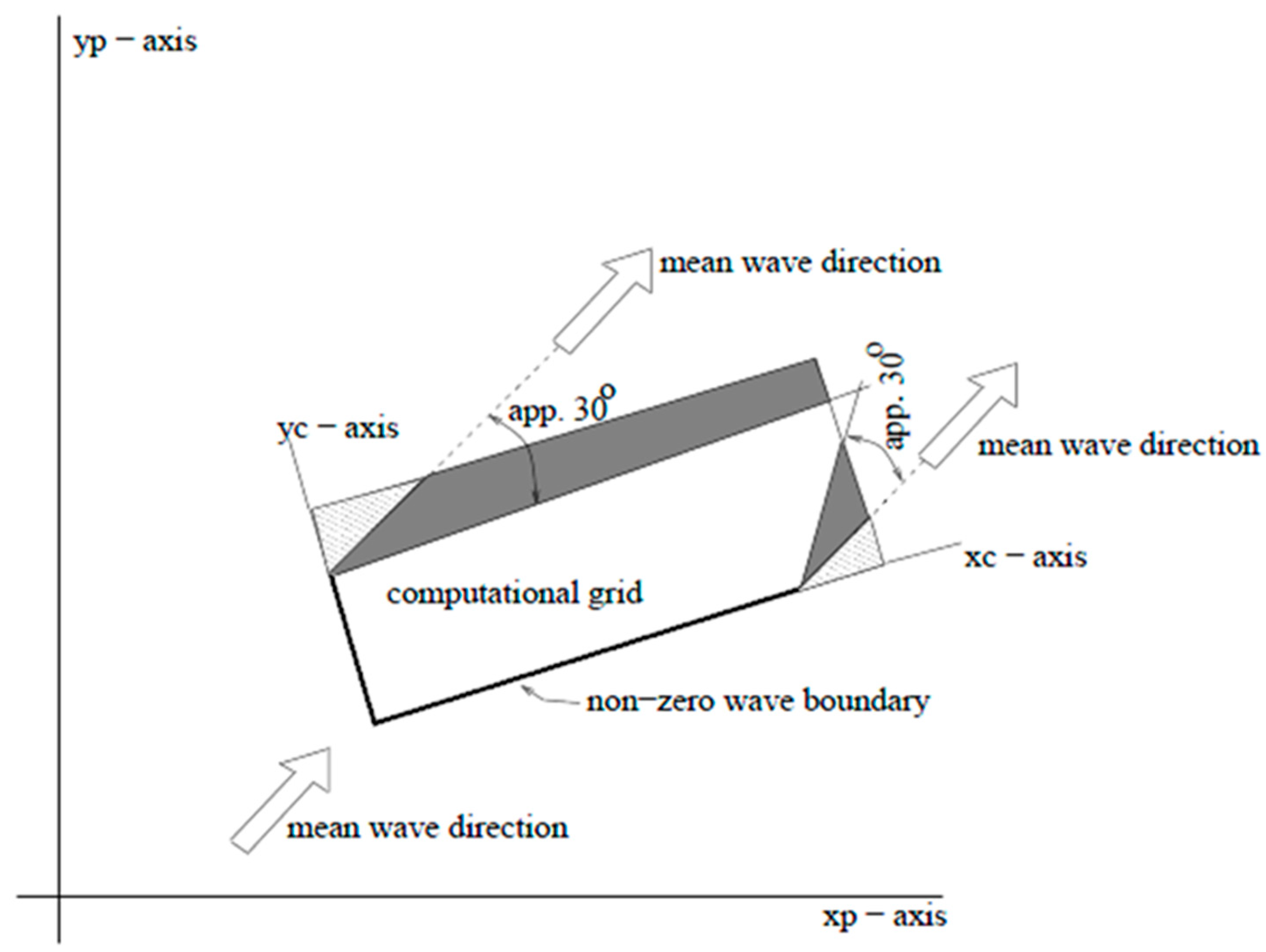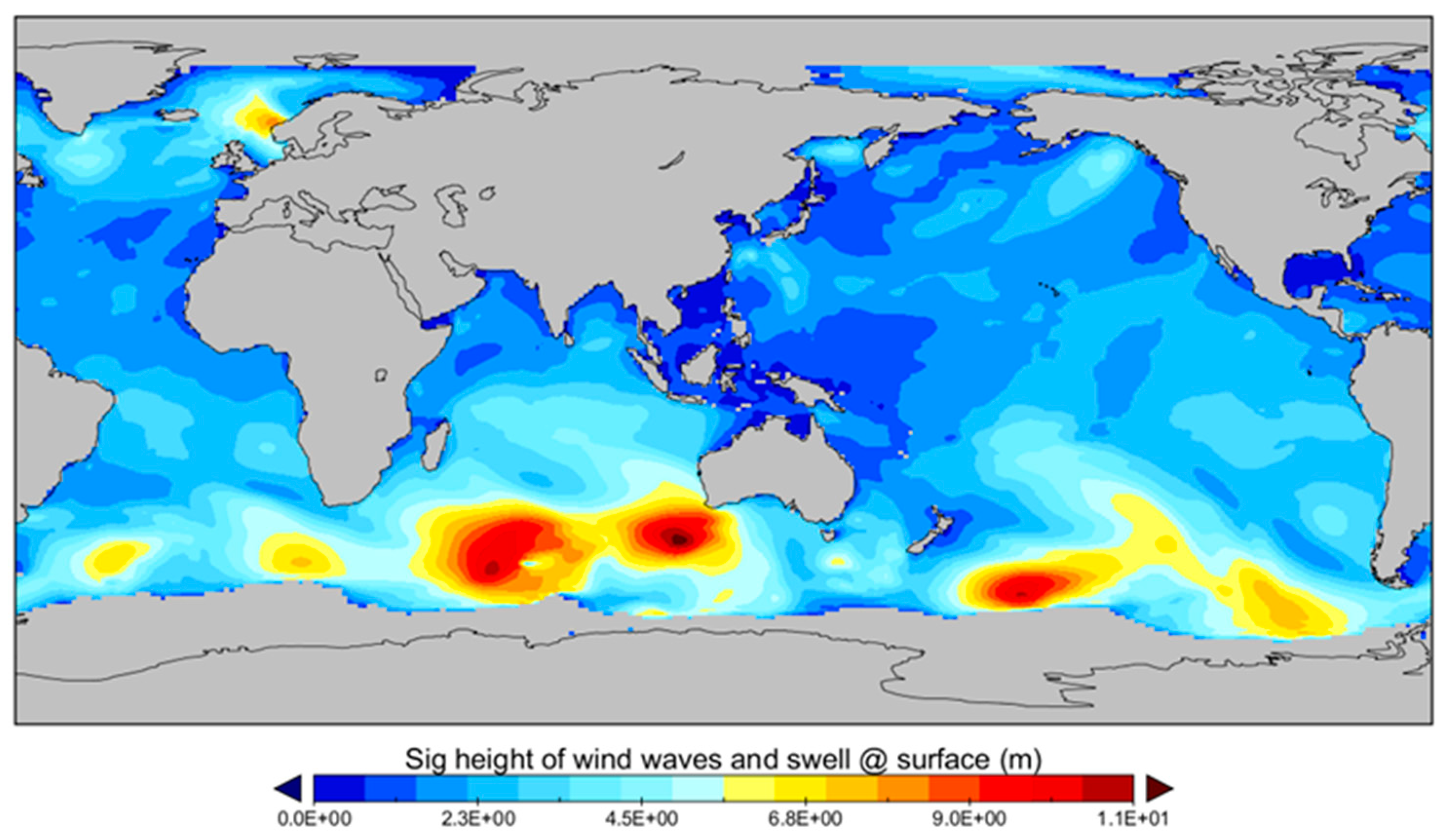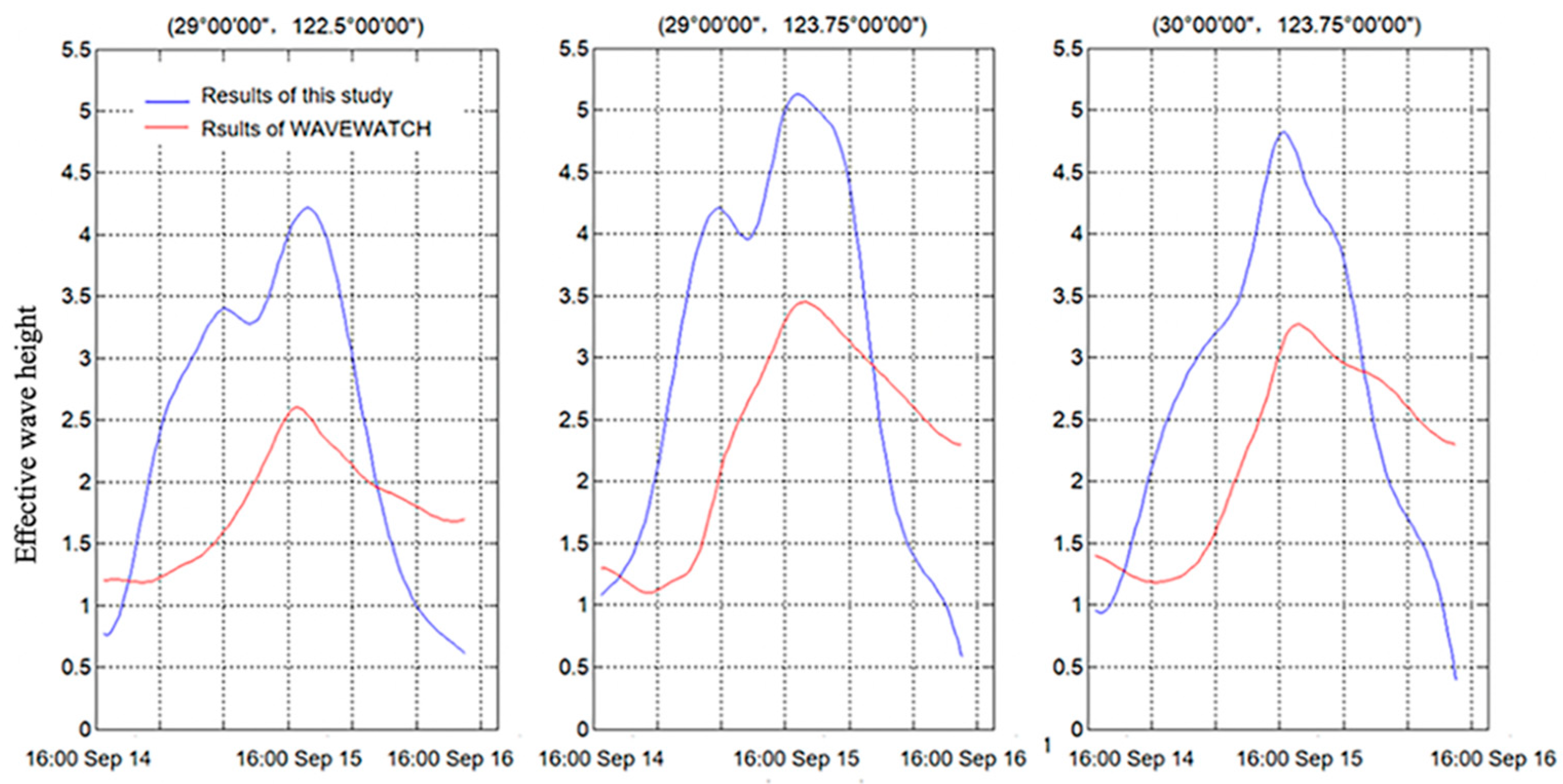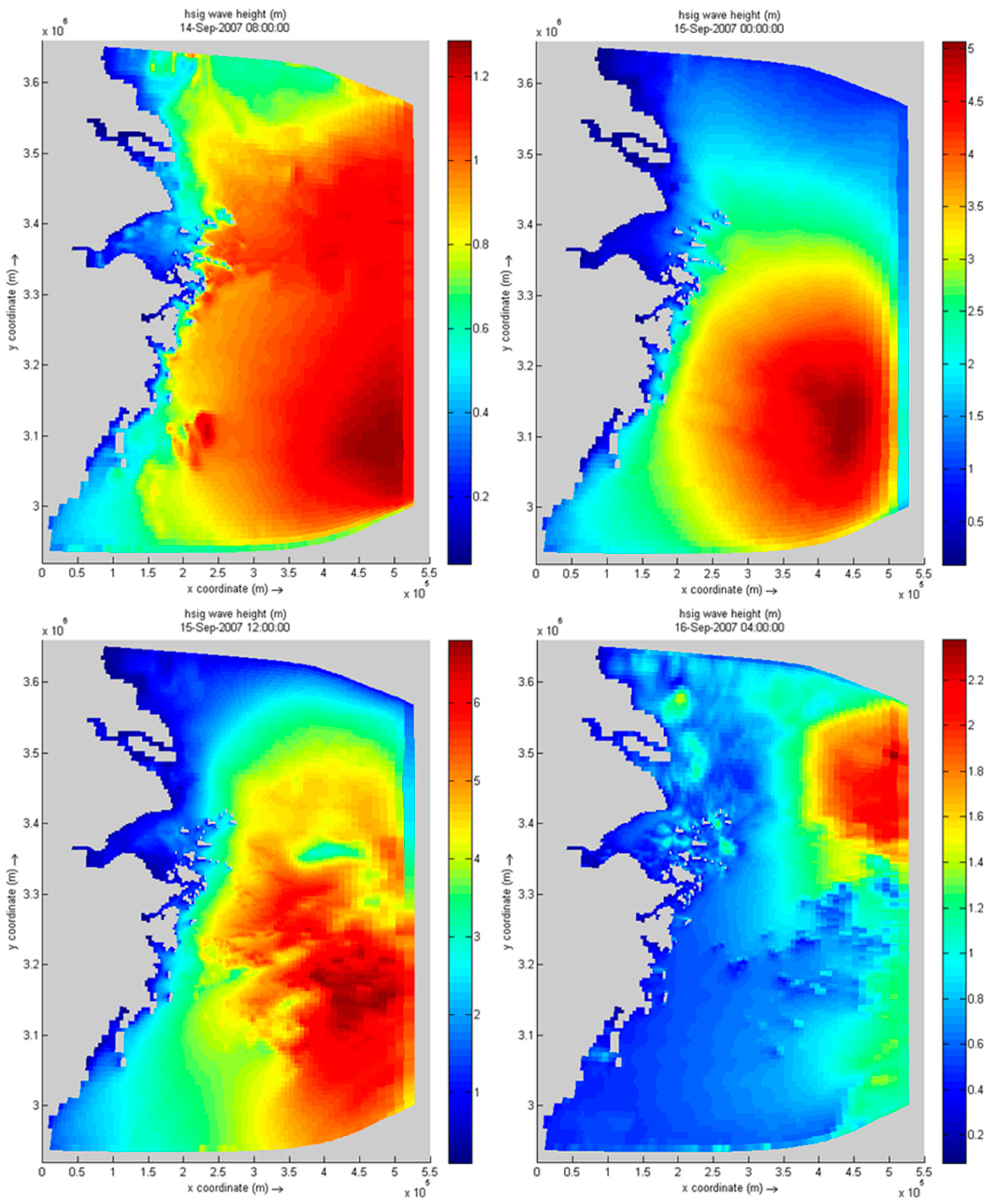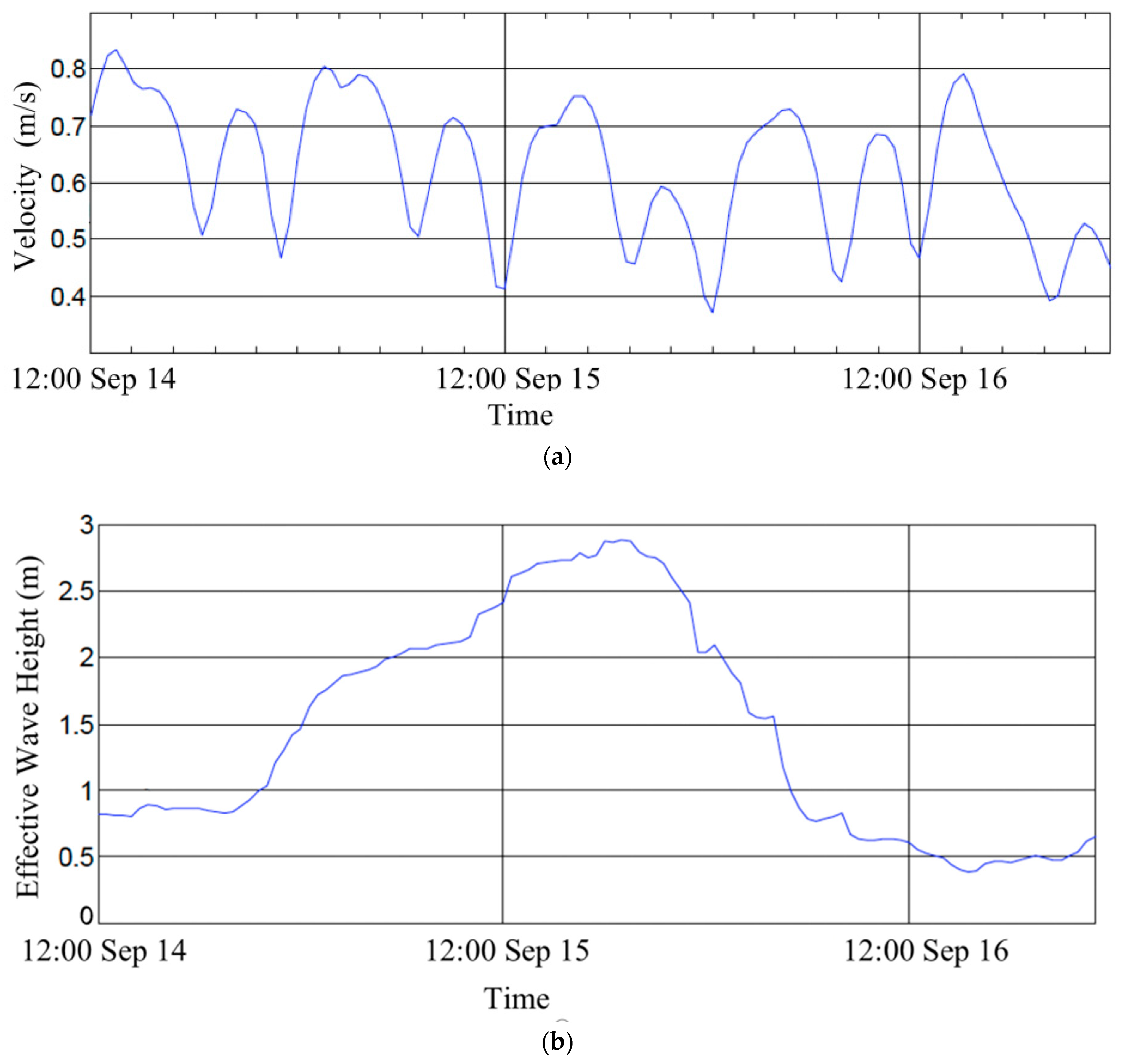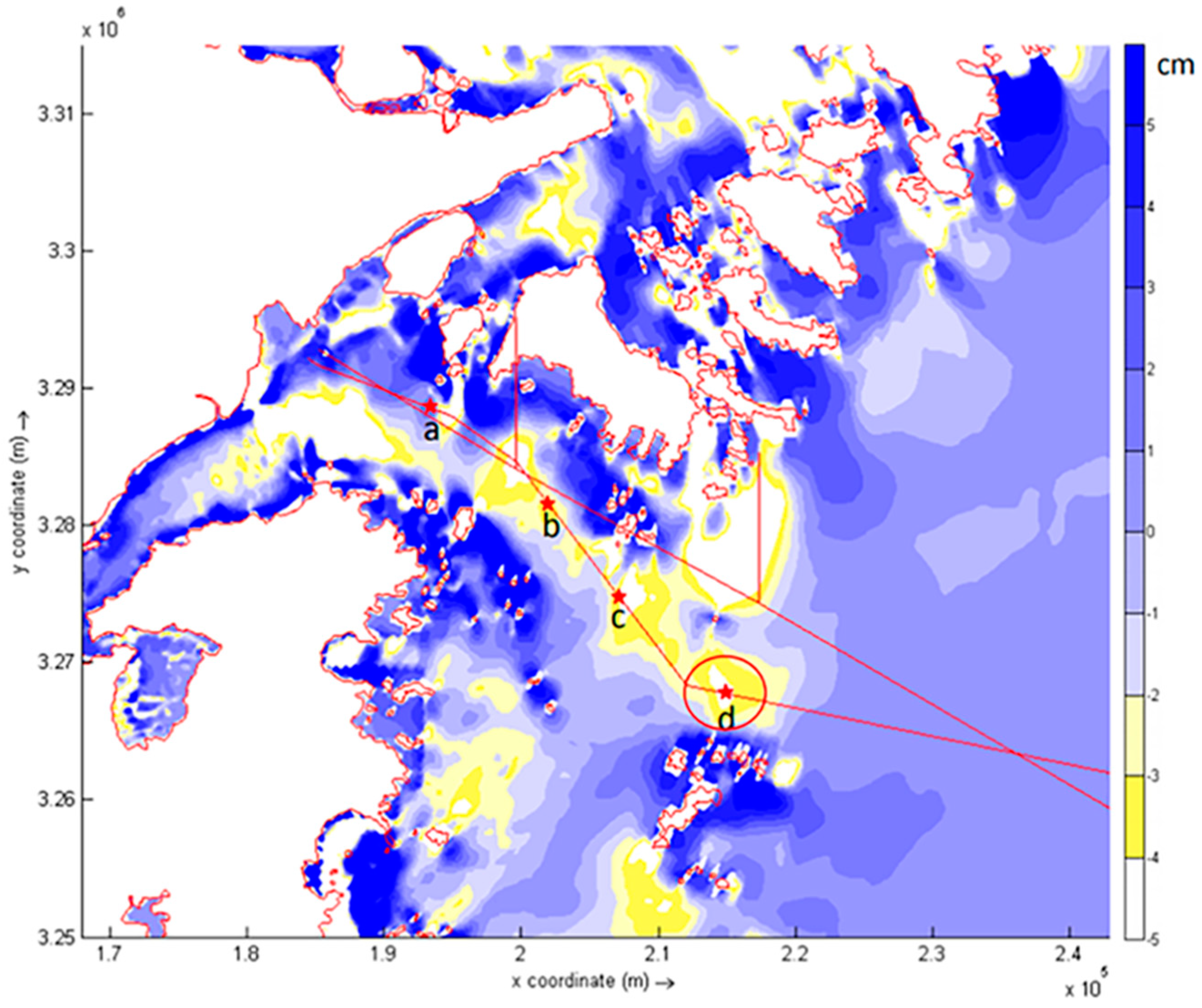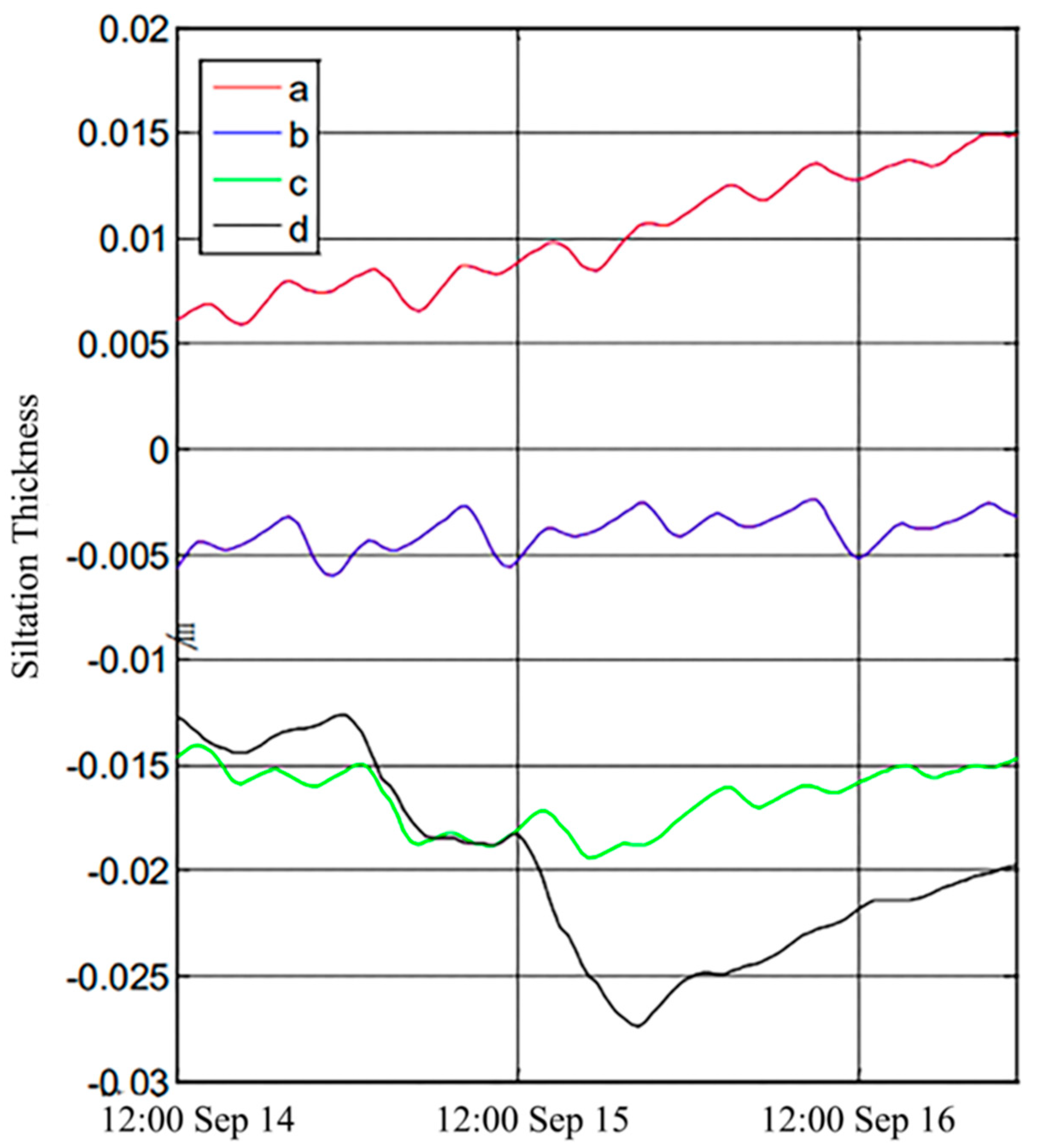2.3.1. Storm Surge Model
Under the assumption of incompressible liquid and shallow water, the Navier Stokes Equations were solved ignoring vertical acceleration. Orthogonal curvilinear grid was adopted for a horizontal plane (Arakawa C-type grid system is used for equation variable arrangement), while σ grid was applied for vertical direction which can fit the terrain. K-ε turbulence model was selected, and finite difference method was used to discrete the equation.
The vertical average mass conservation equation is as follows.
Q represents the role of source and sink, such as drainage and precipitation.
Momentum conservation equation in a direction
:
Momentum conservation equation in a direction
:
In
coordinate, the vertical velocity component is solved by mass conservation equation:
Here, refers to the vertical velocity perpendicular to the coordinate plane, which changes as the coordinate plane moves up and down. In the above formulas, is the water depth, is the water level, and is the water depth relative to the mean sea level; and are the conversion coefficients of curvilinear coordinate system to rectangular coordinate system; U and V are the average velocity in and direction respectively. is the acceleration of gravity; is the parameter of Coriolis force; and are turbulent momentum fluxes in and directions, respectively. and represent the water pressure gradient in and directions; and represent the source or sink of momentum in the and directions, respectively; and represent source and sink items.
ADI scheme is a common method for solving parabolic and elliptic equations in a finite difference method. It is improved from crank Nicolson scheme. It has second-order accuracy in time and space and is unconditionally stable. It divides a time step into two steps and transforms a five diagonal linear equation system into a tridiagonal linear equation system, which greatly improves the computational efficiency and is widely used. In the horizontal direction, the model is discretized by the ADI method.
Among them:
where
is the linear bottom friction coefficient,
is the external force, such as wind and atmospheric pressure. In the first step, the calculation process is from
to
, that is, the calculating time is from
to
. In this process, V Equation (3), U Equation (2) and continuity Equation (1) coupled by free surface gradient are solved; In the second step, the calculation process is from
to
, that is, the calculation time is from
to
. In this process, U Equation (2), V Equation (3) and continuity Equation (1) coupled by free surface gradient are solved.
2.3.2. Storm Wave Model
In SWAN, the wave spectrum is described by the spectral action balance equation given in Hesselmann [
20]. The SWAN model does not use two-dimensional spectral density, but rather uses the two-dimensional dynamic spectral density to represent random waves. In the flow field, the dynamic spectral density is conserved, but the energy spectral density is not. The dynamic spectral density
is the ratio of the energy spectral density
to the relative frequency
. In a Cartesian coordinate system, the dynamic spectrum balance equation is expressed as follows:
In the formula, the first term on the left is the change of wave action with time, the second term is , the third term is the propagation of wave action in geographical space, the fourth term is Doppler shifting caused by topography and current, and the fifth term is refraction caused by topography and current, Is the source term, including wind-induced wave, dissipation, nonlinear wave action and wave breaking. They are the propagation velocity in the direction. is the source term, including wind-induced wave, dissipation, nonlinear wave action and wave breaking. are propagation velocities in direction. Various physical processes considered in the model are input through the right source term, including wind energy input, energy dissipation and nonlinear wave interaction, the specific forms are as follows.
Wind energy input:
The input of wind energy is described by resonance mechanism feedback mechanism in SWAN model:
The coefficients are determined by wave frequency and direction as well as wind speed and direction.
Energy dissipation:
The dissipation of wave energy is mainly composed of three parts, including white wave dissipation , bottom friction dissipation and wave breaking dissipation .
The white wave is mainly controlled by the wave steepness. In the current third generation wave model, the white wave dissipation adopts the Hsselmann formula [
20].
where
is a coefficient related to wave steepness,
and
are average wave frequency and average wave number.
The dissipation caused by topography is mainly caused by bottom friction, seafloor infiltration and reflection scattering of irregular topography. In the continental shelf of a sandy seabed, seabed dissipation is mainly caused by bottom friction, which can be expressed as follows:
where
is the bottom friction coefficient.
For the dissipation caused by wave breaking, swan adopts the following formula:
For the dissipation caused by wave breaking, the following formula is used in SWAN: is the total energy and is the total energy dissipation rate caused by wave breaking. It mainly depends on the wave breaking factor , which can be a constant or a variable in SWAN.
Nonlinear wave interaction:
Nonlinear wave interaction plays a very important role in wave deformation. In deep water, the fourth-order wave interaction determines the evolution of spectral frequency, which can transform wave energy from peak frequency to low-frequency and high-frequency. In shallow water, third-order wave interaction can transform wave energy from low-frequency to high-frequency to generate high-order harmonics. In the SWAN model, the discrete interaction approximation (DIA) and the centralized third-order approximation (LTA) are used to approximate.
Figure 5 shows the disturbed area of numerical calculation results in the model calculation domain under wind and wave conditions. The rectangle represents the calculation water area, the thick solid line represents the wave front boundary with known boundary conditions, the thin solid line represents the lateral boundary of the unknown wave, and the shaded area represents the disturbed area of the model result due to the assumption. In the case of wind wave, the disturbed region propagates from the top of the known wave boundary conditions to the shore in the range of 30–45° with the average wave direction. For the swell wave, the disturbed area will be smaller due to its smaller directional distribution range.
A typical Typhoon Lily in 2007 was selected to calculate the typhoon wave. Its path is shown in
Figure 6. The same water depth and shoreline data are used as that in calculation of storm surge, and the calculation method of wind field is the same.
The verification of calculation results is a difficult problem in wave numerical simulation. Generally, there are three methods: the first is to verify with the measured data, the second is the data collected by the satellite altimeter, and the third is the data provided by other recognized and reliable numerical wave prediction models. Obviously, it is the most ideal if it can be verified by the measured data, but generally there is little chance to obtain the wave data of fixed area and fixed time period. For satellite observation, the reliability is greatly lower than the measured data, and it may not be able to capture the data we just need for the satellite may not be running in the wave calculation time. For the data provided by other models, the biggest drawback is the reliability of the data, especially the nearshore terrain.
Due to the limitation of conditions, the data provided by the global wave prediction model WAVEWATCH III of NOAA is used for verification. The resolution of the model is 1° × 1.25° and there are special calculations for typhoons in some regions such as the Gulf of Mexico. The resolution of the model is relatively high because it is a targeted calculation, and its accuracy is relatively high. Unfortunately, in the East China Sea, this kind of study is not provided.
Figure 7 shows the distribution of global ocean effective wave height predicted by WAVEWATCH III at 14:00 Beijing time on 15 July 2007. Near the East China Sea (the area in the red box), the annular wave field caused by typhoon Lily is clearly discernible. Effective wave height refers to the actual wave height calculated according to certain rules. Since sea waves are actually a random combination of waves with different wave heights, periods and directions, the wave height value of a wave is not representative. For this reason, in any wave group composed of
n waves, the wave heights in the wave train are arranged in order from large to small, and the first 1/3 waves are determined as effective waves. The wave height and period of the effective wave are equal to the average wave height and average period of N over three waves [
19].
In the calculation area of this paper, three effective points are selected for verification, and the verification results are shown in
Figure 8. Although the two values are not in good agreement, the trend of significant wave height change is very consistent, and the peak values of three points appear at the same time. It shows that the model can reflect the response of waves in Zhejiang coastal area when typhoon passes by. The difference of the significant wave height between the two is caused by many reasons, some of which are even unavoidable. First of all, although they belong to the third generation of numerical wave models, there are differences in theory, especially in the nearshore, the processing of various physical processes is not the same, in addition, the input of wind energy is not consistent; secondly, the three boundaries of SWAN model in this paper cannot provide real boundary conditions, which will certainly affect the calculation accuracy; finally, the WAVEWATCH of NOAA in terms of the accuracy of typhoon analysis, is lower than that of the global wind field.
Comparing the significant wave heights at different locations, it is obvious that the points in the open sea (with greater longitude) have larger peaks, and the points in the South have larger peaks than those in the north. It can be seen from
Figure 8 that the two calculation results are consistent.
Although the two lines of effective height do not correspond well, they are very consistent in terms of the trend of effective wave heights, and the peaks of the three points all appear at the same time. For this research, the ultimate purpose is not to study the platform wind and wave itself, but to consider the influence of waves on the seabed shear stress and scour effect. Therefore, such a result is acceptable. This shows that the model can reflect the wave response in the coastal area of Zhejiang when a typhoon passes by. In addition, the difference of effective wave heights between the two is also caused by many reasons, some of which are even unavoidable. First of all, although both belong to the third-generation numerical wave model, there are theoretical differences, especially in the nearshore, the processing of various physical processes is not the same, and the input of wind energy is not consistent. Secondly, none of the three boundaries of the SWAN model in this paper can provide real boundary conditions, which will certainly affect the calculation accuracy. Finally, NOAA’s WAVEWATCH III forecast value is for the whole world, with a relatively low resolution. Due to the topography and other factors, the accuracy of the near shore is relatively poor. For the regions affected by the typhoon field, there is no detailed wind field, which is bound to affect the calculation accuracy.
Figure 9 shows the distribution of significant wave height at four typical moments in the calculation area under Typhoon Lily. The four stages are: (a) when the center is far away from the calculation area, the wind field has little influence on the region, so the wave is mainly controlled by the open sea boundary; (b) when the typhoon is close to the calculation area, the regional wave is obviously affected by the wind field, thus the effective wave height of the region affected by strong wind began to increase significantly; (c) after the effect of the wind field on the region has lasted for appropriately 10 h, the wave is significantly increased, and the typhoon center is closest to the center of the region, which is also the time when the typhoon field has the strongest impact on the entire region. At this time, the wave of the whole region reaches its peak; (d) the typhoon leaves slowly to the north, the wind field begins to weaken, and the wave also weakens.
It can also be seen from
Figure 9 that although the nearshore is not directly affected by a strong typhoon field, the effective wave height is about 3 m due to the wave conduction from the open sea. In Zhoushan Archipelago, due to the blocking effect of many islands on waves, the wave height in the Western sea area of the islands is obviously smaller.
2.3.4. Scouring Model
A coupled large-area model is established with consideration of ocean dynamic elements under typhoon, such as the interaction of waves and currents. Meanwhile, the scouring and silting of the offshore areas with complicated topography during typhoon was investigated, which help understand the scouring and silting rules of the area where submarine pipelines are located.
The sediment transport module was used to simulate the transport of cohesive and non-cohesive sediment (such as the diffusion of dredged material) and to study the sediment deposition/erosion model.
The appropriate boundary conditions are used to solve the two-dimensional convection-diffusion equation. In sediment calculation, the two-dimensional diffusion equation of suspended sediment is as follows:
For the study area which is dominated by cohesive fine-grained sediment, full silting model was used to calculate the sediment erosion and deposition rate which were simulated by the Partheniades–Krone equation [
18]:
where
represents the scour sediment flux;
represents scour coefficient;
represents deposition flux;
represents sediment settling velocity;
is average sediment concentration near bottom.
and
are respectively expressed in the following equation:
where
represents the critical shear stress of sediment erosion,
denotes the critical shear stress of deposition,
is the shear stress on the bed surface.
The bed sediment transportation will lead to the change of bed elevation which is directly determined by the sediment deposition flux and suspended flux, expressed as:
where
are the sediment transport components, zb is the bed elevation,
is the bed porosity, which is generally 0.4.
is the bed silting deposition or erosion rate,
=
D −
E.
